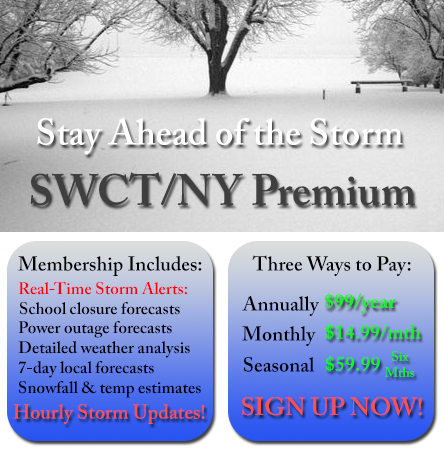Below is the latest forecast for the upcoming blizzard:
Mostly sunny skies dominate for the rest of the day with high temperatures in the low 30s. Overnight clouds rapidly increase, with a chance of snow arriving after midnight. Snow begins light between 1 and 3 AM across the region, picking up in intensity by 4 or 5 AM by which point all travel will become dangerous and snowfall rates above an inch per hour can be expected.
Heaviest snow tomorrow falls between 7 AM and 12 PM with high tempeatures in the low 30s. The heaviest snowfall rates could peak out at 3-4 inches per hour during this timeframe, at which points thundersnow would be a real possibility as well. Between 9 AM and 12 PM sleet and freezing rain could mix in with snow across coastal regions as warmth moves in aloft. This will compact snow a bit and keep snowfall ratios around 10:1, if even a bit less. Snow quickly tapers off between 12 and 4 PM across the region, with lingering snow showers into the evening.
We could see a couple lingering snow showers Tuesday night on the backside of the storm as winds remain breezy. Low temperatures drop into the upper teens with wind chills dropping into single digits, especially inland.
Wednesday looks to start mostly cloudy with maybe a few lingering snow showers, but most accumulating snow should have already ended. High temperatures get into the low 30s as we clear out.
Model agreement on the storm is stronger on very significant snowfall accumulations across the region. No longer does there appear to be that much of a risk of the storm sliding to our east, meaning we should see the heaviest precipitation at least partially across the region. This means that there are two main things to track: banding and mixing. Most models show 1.5-2.5 inches of QPF across the region, which on a 10:1 ratio with the sun angle in March that would lead to 15-25 inches. However, there is going to be a risk of mixing across coastal areas, which could limit accumulations to around 12 inches. That said, 12 inches across all guidance looks a virtual guarantee, with a maximum of 24-25 inches in the heaviest banding. The new forecast now is for 12-20 inches of snow widespread across the region, with isolated amounts to 24 inches in the heaviest banding possible. That banding is most likely to be further inland, as now it appears that accumulations may be a bit more limited by the coast where there will be some mixing with sleet/freezing rain at the peak of the storm. The storm is fast moving enough that more than 2 feet looks unlikely, but even that would be enough to cause enormous problems.
As mentioned previously, the two things to focus on are mixing and banding. If at the peak of the storm there is mixing along coastal regions, accumulations from 12-16 inches are more likely than from 16-20+ inches. If there is no mixing at all we could even see more than 20-24 inches where the heaviest pecipitation occurs, but at least some sleet looks possible. It will be important to track the mid-level atmospheric low pressure center that will move near the region and determine how far inland warmer air gets. It is impossible to know the exact orientation until the storm really gets going, as short-range models tend to struggle with such features. The same can be said with banding, which is hard to identify until inside of 12 hours.
Wind gusts in the storm look to get up to near 50 mph. Luckily, surface temperatures in the upper 20s/lower 30s through much of the storm will keep the snow from being quite as sticky, so concerns about downed tree limbs are not quite as high, but some downed limbs are possible. Isolated power outages by the coast are also possible Tuesday. The strongest winds will be near the coast from Tuesday mid/late-morning through the evening as the storm rapidly intensifies. Moderate coastal flooding is likely as well as water gets pushed up along the coast, as the storm looks likely to be very strong. However, winds will be worse across the Mass coast than in SWCT/NY. Winds peak in intensity between 9 and 11 AM when most power outages would occur.
The National Weather Service has upgraded the entire region to a Blizzard Warning, as expected. They are similarly calling for 12-20 inches of snow now, with decent agreement overall. It is hard to see significant changes to the forecast unless there is a warmer trend with more mixing that would limit accumulations. Otherwise, at least a foot of snow looks like a guarantee with impacts lingering into Wednesday.


